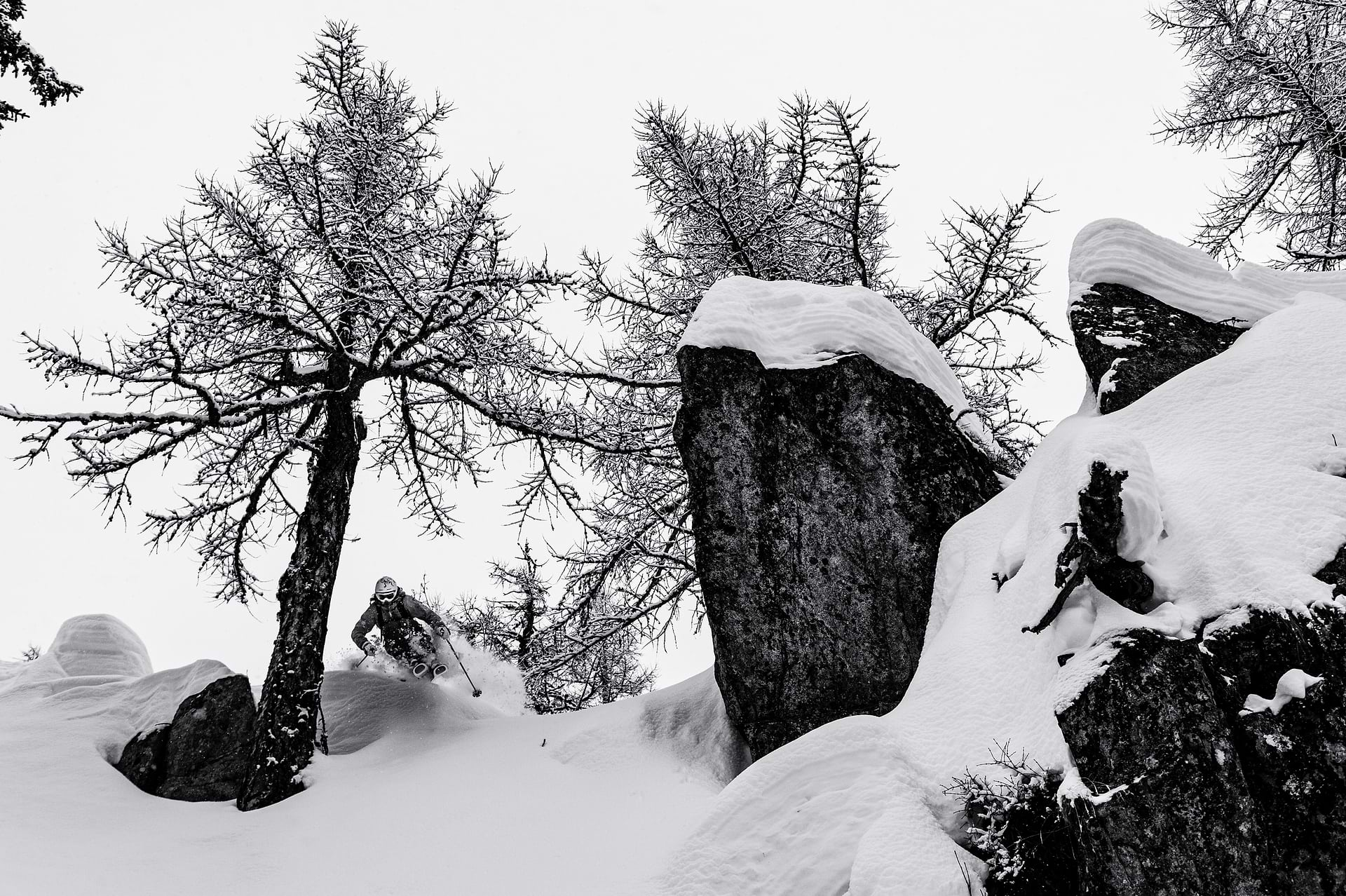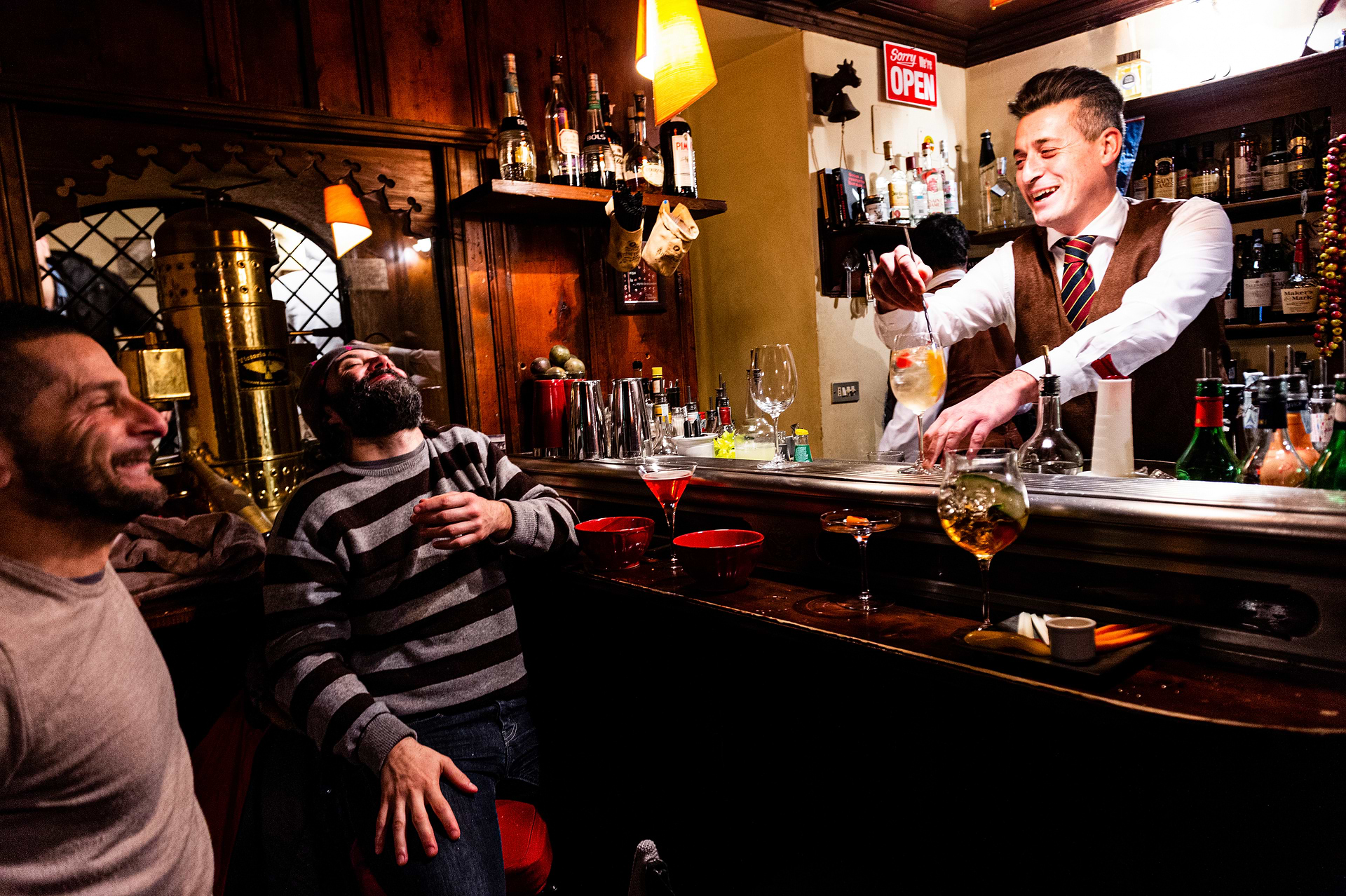
Courmayeur, Italy
Come for the food — stay for the skiing. Or the other way around.
Classics
Words by: Leslie Anthony
Photos by: Mattias Fredrikson
The alpine circus of Chamonix, France may be only 22 kilometres away through a tunnel, but Courmayeur, on the Italian side of the Mont Blanc massif, feels like another planet.
While Chamonix floods annually with mountaineers and powder-hungry expert skiers from around the world, there’s never a fight for untracked snow above historic and laid-back Courmayeur in the Aosta Valley. And yet, like Cham’s Aiguille du Midi, Courma’s Punta Helbronner offers a similarly classic ski-mountaineering venue. A place of colliding sensibilities for centuries, Courmayeur’s “posh soul” nevertheless delivers some excellent skiing — and the best food in the Alps.



Local Knowledge
By European standards, Courmayeur isn’t a big ski area, but the terrain is still vast. Southeast-facing Plan Chécrouit, above the town, and the northwest-facing Val Veny are connected and offer breathtaking views of Monte Bianco, whose blue-toothed glaciers feel within reach of your fingertips. Monte Bianco Courmayeur, or simply just the Helbronner sector, is served by the efficient and modern Skyway Monte Bianco trams, a technological and engineering marvel installed in three stages as late as 2015.

Pistes on Chécrouit
are wide open, cross annoyingly often, and draw the biggest crowds. The highest point is 2256-meter Col Chécrouit, from where you either drop directly into Val Veny’s piste-and-glade mix, or grab the Youla tram aloft to 2624 meters, and, when running, continue to 2755 meters on the aging sardine-can Arp tram.

From the top of either Youla or Arp,
open powder bowls segue into some of the best tree-skiing in the Alps — slope-to-bench after slope-to-bench of open larch forests that deliver you to the valley bottom and a short shuffle back to the lifts through a scenic rural landscape.

When skiing off the Skyway Monte Bianco,
above the village of Entrèves, hire a guide unless you know the terrain and are used to skiing in glaciated and exposed terrain. Most of the lines from Punta Helbronner are complex, even a standard run down the Toula Glacier.

Another option
is to climb up towards Tour Ronde and descend the Brenva Glacier, with Mont Blanc towering above you, all the way down to the tunnel, ca 2300 vertical meters. Or cross the Géant Glacier to descend various classic routes over to Chamonix (don’t miss the bus back to Italy, and make sure to bring your passport!).




Eat, Drink and be Merry

Courmayeur’s on-mountain restaurants
are easily the best in the Alps. Lunch at the infamous Maison Vieille is often a raucous mid-day party with host Giacomo Calosi at the center. Ski-in bistros La Chaumière and Ristorante Chiecco are excellent and also open for dinner, with well-worn lifts from the village running until midnight.

There are many places to land after skiing,
but Cafè Roma, literally oozing après buzz, is popular with the freeski crowd. One reason: a free buffet. Others to check off: American Bar for beer and burgers, and Le Privé for well-rendered cocktails, wine and service.

Local Morgex et de la Salle wine,
made from the Prié Blanc grape grown only here in one of the Alps’ highest vineyards, is available everywhere in Courmayeur. Still, a logical spot to try it is La Clochette, whose woodcut doors depict elaborate scenes of the grape harvest and wine production.

As you might expect,
pizza is as ubiquitous in Courmayeur as the town’s ancient cobblestones. Pizzeria Ristorante di Tunnel’s two-level bustle never disappoints, but Fuoripista typically draws the nod for top taste honours, while Mont Frety is the choice for casual ’za with football.

Artisan food specialties
in Courmayeur are unparalleled, even in a region dedicated to such crafts. You don’t even need to eat the salami hanging in Macelleria Monte Bianco to know how good it is. Panizzi Courmayeur for cheese, Enoteca Goio for wine.

A special place is reserved in most visitors’
hearts for the well-respected Cafè Della Posta, rumored to have the best cappuccino in the Alps. Whether true or not matters little, only that it’s in the mix. The historic, timeless street façade also draws in strollers for wine and aperitifs.
Sleep
Expect the usual mishmash of old and new, with more of the former. Courmayeur’s hotel bed base is surprisingly tiny because many rentals, second homes, and apartments serve this purpose. Still, there’s plenty to choose from: budget-wise you’ll find the landmark iH Hotels Courmayeur Mont Blanc; moving up the scale is the charming and family-run (since 1882!) Hotel Berthod, the boutique GranBaita Hotel & Wellness Resort, and contemporary alpine hotel Cresta et Duc; at the high end sits the venerable Au Coeur des Neiges, Grand Hotel Royal E Golf, and Villa Novecento Romantic.



Other Stuff
Courmayeur’s main non-alpine activity is strolling the historic cobblestoned town that dates to the 1200s and popping into shops, sipping espresso, and slipping into cafes for a genepi — a local aperitif.
A walkway through a small park commemorates those who’ve been guided in these mountains going back to 1850. Names embossed in alphabetical order on granite stones lead to the Società Della Guide (guiding and heli-skiing services) housed in the renovated Alpine Museum Duca Degli Abruzzi — itself well worth a walk-through.
Courmayeur has always attracted royalty and celebrity. That tradition is honored on weekends when Via Roma becomes a see-and-be-seen catwalk for non-skiing Milano and Torino fashionistas. Join the crowd and benefit from a food and drink scene catering to demanding visitors.
Even if you ski with a guide over the top and down into Chamonix, it’s worth a trip through the refurbished Mont Blanc tunnel to the French side, either just for the transit experience or to have a comparative taste of French mountain culture and food.
There are several rifugios in the Courmayeur area that draw ski touring enthusiasts. A classic is the Rifugio Cesare Dalmazzi, located near the Tratto Attrezzato and Aiguille Rouge de Triolet. Hire a guide to make your experience safer and more enjoyable.
Don't Miss
Punta Helbronner: Replacing a series of creaky cable cars that took 40 minutes to ascend, the two rotating trams of Monte Bianco Skyway — a de facto engineering wonder — now deliver you to 3,462-metre Punta Helbronner in 15 minutes. From here, you have access to the Toula Glacier, Couloir Marbrées, and other off-piste gems. You also gain spectacular views over the Mont Blanc massif and can see the weather-dependent gondola that connects to Chamonix’s Aiguille du Midi during summer.


Just the Facts
The skiing on Plan Chécrouit, accessible both directly from town and from the hamlet of Dolonne, is straightforward. Not so much the more complex Val Veny sector, which you can reach either from the main area or a tram from Entrèves.
• Skiable area: 42 km of piste, 100 km off-piste runs
• Parks: 1
• Longest run: 7.5 km
• Terrain mix: 31%/55%/14%
• Lifts: 20, including the two-stage Skyway Monte Bianco
• Average annual snowfall: 7 m
• Snowmaking coverage: 80%
• Vertical: 1,545 m; top elevation 2,755 m
Getting there: Courmayeur sits at the head of Valle d’Aosta, 150 km north of Turin. Gateway airports include Turin, Milan, and Geneva, all 1.5-2 hours distant. Transport options include car rental, private transfer, and public train/bus combos.

LESLIE ANTHONY is a writer and editor who knows a thing or two about snow. Longtime Creative Director of SKIER, former Managing Editor of POWDER, and author of the book White Planet: A Mad Dash Through Modern Global Ski Culture, the resident of Whistler, British Columbia, continues to appear regularly on the masthead of the world’s top ski magazines. His favorite activity? Skiing powder, of course.
RELATED STORIES